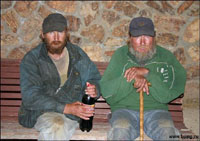Russia’s richest and poorest regions become a stumbling block for its development
Irina Ermish, head of the Committee for social security of the Ivanovo region, meets desperate people in her office everyday. Those who have been pushed to the limits while fighting poverty for many years. The people have been coming to her office day in and day out for many years.

In the Ivanovo region there are hundreds of thousands of poor people who cannot make both ends meet. Last year 214 thousand people received urgent help e.g. soup kitchens, food packages. The local offices of social security service keep files for 397 thousand residents of the region. In other worlds, every third resident of the Ivanovo regions is officially filed under the poor and needy. In reality, the number is greater.
The 43-year old Inna Gorshunova lives from hand to mouth. Her husband was a warrant officer. He died a sudden death five years ago after having a stroke. Irina has four underage children to support. She is a social worker. Irina looks after the lonely elderly, working hard from morning till night. She buys groceries, cleans and cooks for them. She also tries to comfort them. Her regular wages are 1,892 rubles. How on earth can she keep the wolf from the door?
“I just don’t get it. They pay me peanuts for doing tough and important work. Does this compensation fit the amount of work I do?” After paying the utilities, Irina is left with 47 rubles per family member each month.
“We usually subsist on soup. We have it on breakfast, lunch, and dinner. I cook soup out of two potatoes and a carrot, with a couple of onions and some flour fried in vegetable oil. My kids forgot how meat and fruit look like. They don’t complain, though. They’re fully aware of our situation. Thank God, there’re kind people who give us shoes and clothing. Anyway, I feel like crying out loud sometimes,” says Irina.
The situation in the Ivanovo region is by no means an exception to the rule. The gap between Russia’s richest and poorest regions is becoming increasingly wider. Experts at the All-Russian Center for Standard of Living Studies have released the preliminary estimates of average money incomes of the population for each region of the Russian Federation as for the first half of 2006. Doctor of Economics Vyacheslav Bobkov, director of the center, comments on the findings:
“In terms of social conditions, 11 regions of the Russian Federations are still in dire situation. As for the average income, every second or third resident in those regions is below the poverty line. The regions are as follows: Kalmykia, Inguyshetia, Tuva, Mariy El, Altai, Adygeya, Buryatia, Ivanovo region, along with Ust-Ordyn Buryat, Evenk, and Agin Buryat autonomous regions.
The so-called “advancedareas” have a lotsmaller portionof disadvantaged population, it is by 2.5-9 times smaller than that of the outsiders. The following regions sit on top of the list: Khanty-Mansiysk, Yamalo-Nenetsk autonomous regions (the regions are rife with oil and gas), along with St. Petersburg, Tyumen region, Kemerovo region, Sverdlov region, Moscow, and Tatarstan. The percentages of disadvantaged people range from 8% to 13.5% in the above areas.”
It is no wonder that Moscow looks like a city of another world to those who come from the provinces. In a unified state the difference between the social strata and regions should not give rise to antagonism or separatism.
“The standard formula for comparison purposes has the gross national product per capita calculated by the purchasing power parity.
According to the formula, we didn’t have any regions in Russia with a low level of regional product per capita in 2005. We don’t have any regions like that in 2006 either. In other words, the total amount of goods and services equals to more than $800 per person. On the face of it, there is no reason whatsoever for those appalling data regarding the standard of living. Only the three regions – the republics of Adygeya, Dagestan, Ingushetia – had the indicator (gross nation product per capita) falling below the average level. All the rest have good figures, by and large. However, the population of those 27 regions with a high level of economic development has low purchasing power. The “high purchasing power” means a person’s average income can buy him seven or more baskets of foodstuffs, manufactured goods, and services that make up a minimum subsistence level. Only the residents of six regions and cities, namely Moscow, Tyumen region, Khanty-Mansiysk and Yamalo-Nenetsk autonomous regions, St. Petersburg and Republic of Komi have purchasing power that is slightly higher that the average level (good enough for buying from 3 to 6 of the above baskets). On the other hand, the standard of living in the remaining parts of this country was well under the relatively low level (equals to 2-3 minimum subsistence baskets by income per capita).”
Some people spend millions of dollars on fancy yachts and football clubs, while two-thirds of Russia’s population does not have any money in the bank. One out of six Muscovites live below the poverty line. Speaking at a session of the State Council, President Putin said that in terms of funds spent on social security in the regions, the difference was huge, up to 15 times. The difference in spending on education per capita in the regions exceeded 5 times, the difference in spending on health exceeded 6 timers. “Under the circumstances, we won’t do without interdepartmental programs aimed at leveling the situation,” said President Putin.
Subscribe to Pravda.Ru Telegram channel, Facebook, RSS!


